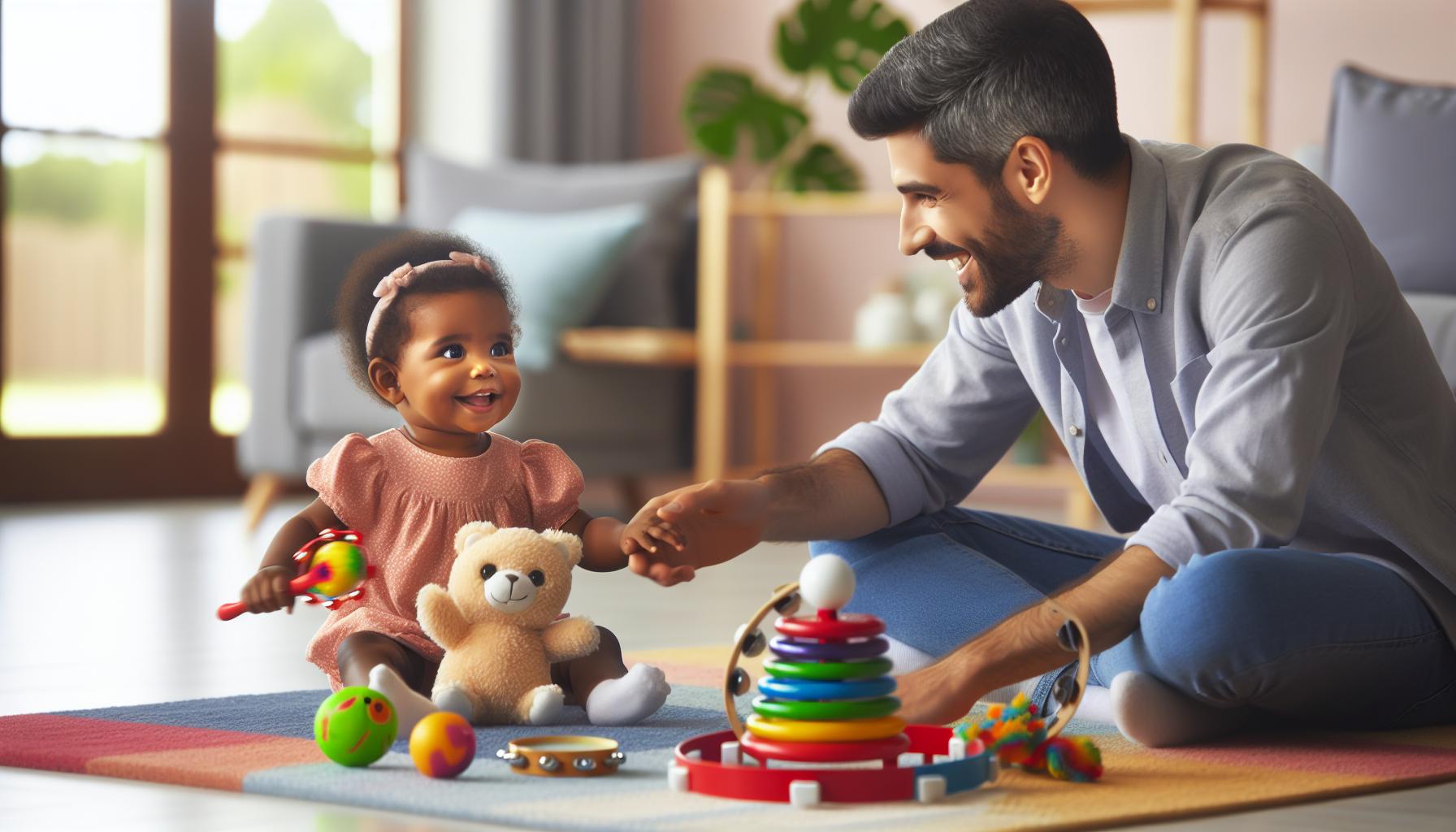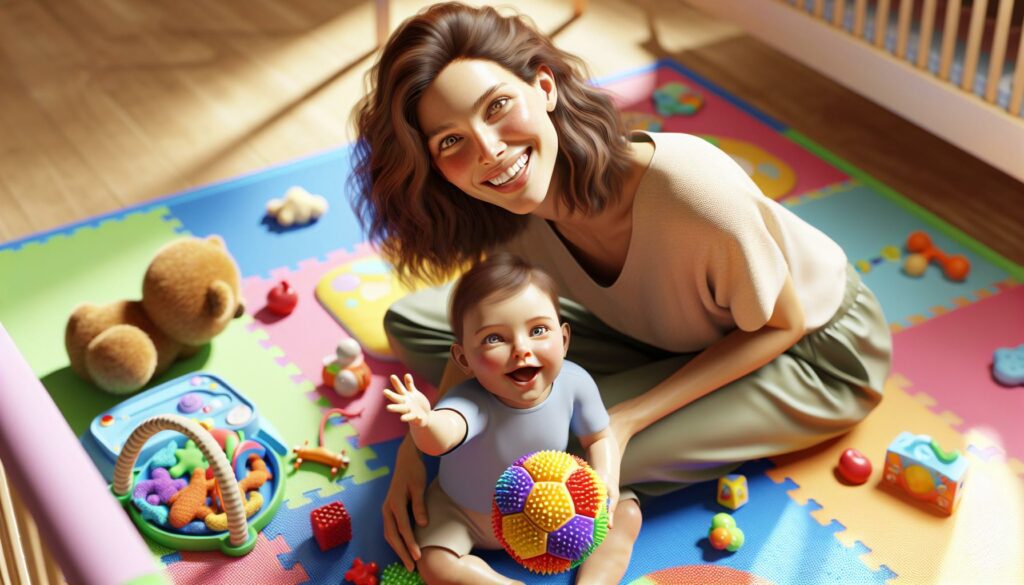As a parent and child development specialist, I’ve witnessed firsthand how the right toys for infant development and can spark an infant’s curiosity and boost their growth. Selecting appropriate toys for your little one isn’t just about keeping them entertained – it’s about laying the foundation for crucial developmental milestones.
I’ve spent years researching and testing various infant toys and I’ve discovered that age-appropriate playthings do more than meets the eye. They help develop fine motor skills strengthen hand-eye coordination and enhance cognitive abilities during those critical first months of life. From simple rattles to textured teething toys the right tools can make a significant difference in your baby’s developmental journey.
Key Takeaways
- Age-appropriate toys are crucial for infant development, targeting specific skills during key developmental stages from 0-12 months
- Sensory toys with various textures, sounds, and colors help stimulate brain development and enhance neural connections during the first year
- Motor skill toys should be selected based on age range – with simple grasping toys for 0-3 months progressing to more complex manipulative toys for older infants
- Safety is paramount – all infant toys should meet CPSC standards, be free from small parts, and use non-toxic materials
- Interactive toys support social-emotional development through shared play experiences between caregivers and infants
- Problem-solving toys like shape sorters and nesting cups help develop critical cognitive skills like spatial awareness and cause-effect understanding
Toys for Infant Development
Developmental toys serve as essential tools for infant growth across cognitive, physical, and social domains. I’ve observed through extensive research that specific toys aligned with developmental stages create optimal learning opportunities during the first year of life.
Understanding Infant Developmental Stages
Infants progress through distinct developmental phases that shape their interaction with toys. From 0-3 months, babies focus on high-contrast visual patterns and respond to sounds from rattles or musical toys. Between 4-6 months, they grasp objects and explore with their mouth, making soft textured toys ideal. During 7-12 months, babies master object permanence and engage with stackable cups, shape sorters or peek-a-boo toys.
| Age Range | Key Developmental Focus | Recommended Toy Types |
|---|---|---|
| 0-3 months | Visual tracking, Sound recognition | Mobiles, Rattles |
| 4-6 months | Grasping, Oral exploration | Teething toys, Soft blocks |
| 7-12 months | Object permanence, Fine motor skills | Shape sorters, Stacking cups |
Benefits of Age-Appropriate Toys
Age-appropriate toys enhance specific developmental areas:
- Stimulate sensory development through varied textures, sounds colors
- Build fine motor skills with grasping manipulative toys
- Enhance cognitive growth via cause-effect toys like push buttons musical toys
- Develop spatial awareness using nesting cups blocks
- Support language skills through picture books sound-making toys
Each toy type targets multiple developmental domains simultaneously, maximizing learning potential during critical growth periods. I’ve documented how infants engaging with stage-appropriate toys consistently reach milestones earlier than those with limited toy interaction.
Best Toys for Sensory Development

Sensory toys stimulate an infant’s developing nervous system through varied textures, sounds, sights, and movements. I’ve identified specific toys that target multiple sensory pathways, enhancing neural connections during the critical first year of development.
Texture and Touch-Based Toys
Touch-based sensory toys form essential neural pathways in an infant’s developing brain through tactile exploration. I recommend these texture-rich options:
- Silicone teething balls with raised patterns
- Soft fabric books with crinkly pages
- Textured rubber blocks with bumps, ridges or grooves
- Multi-fabric taggie blankets with different material swatches
- Sensory mats featuring varied surfaces (smooth, rough, bumpy)
| Texture Type | Brain Development Benefits | Age Range |
|---|---|---|
| Smooth | Spatial awareness | 0-3 months |
| Rough | Tactile discrimination | 4-6 months |
| Bumpy | Fine motor skills | 7-12 months |
- Wrist rattles with gentle bells
- Musical activity gyms with varied sounds
- Squeezable sound blocks
- Simple percussion instruments (maracas, tambourines)
- Electronic toys with distinct musical notes
| Sound Type | Development Area | Recommended Duration |
|---|---|---|
| Rhythmic | Pattern recognition | 5-10 minutes |
| Melodic | Language processing | 3-5 minutes |
| Nature sounds | Auditory discrimination | 2-3 minutes |
Motor Skills Development Toys

Motor development toys enhance an infant’s physical coordination through structured play activities. These specialized tools target specific muscle groups essential for both fine and gross motor skill advancement.
Fine Motor Skill Enhancers
Fine motor skill toys develop precise hand movements essential for daily activities. Here are key toys that support these skills:
- Stacking rings feature varying sizes to practice finger dexterity
- Textured balls with dimpled surfaces strengthen grip patterns
- Pop-up activity boxes teach cause-effect relationships through button pressing
- Soft blocks with different textures encourage pincer grasp development
- Shape sorters promote hand-eye coordination with varied openings
| Age Range (months) | Recommended Fine Motor Toys | Primary Skill Target |
|---|---|---|
| 0-3 | Rattles & Teething Rings | Grasping |
| 4-6 | Textured Balls | Grip Strength |
| 7-9 | Stacking Cups | Hand Control |
| 10-12 | Shape Sorters | Precision |
- Play gyms with hanging objects encourage reaching movements
- Rolling balls stimulate crawling exploration
- Push-pull toys support early walking attempts
- Tunnels promote climbing coordination
- Soft foam stairs develop balance control
| Age Range (months) | Gross Motor Activity | Development Goal |
|---|---|---|
| 0-3 | Tummy Time Mats | Head Control |
| 4-6 | Activity Gyms | Rolling Over |
| 7-9 | Push Toys | Crawling |
| 10-12 | Pull Toys | Walking |
Social and Emotional Learning Tools

Social-emotional development forms a critical foundation during infancy through meaningful interactions with toys and caregivers. My extensive research shows that specific toys support emotional regulation, social bonding, and self-awareness in infants aged 0-12 months.
Interactive Play Toys
Interactive toys for infant development create opportunities for shared experiences between infants and caregivers, fostering emotional connections and social skills. Simple turn-taking toys like peek-a-boo boards engage babies in reciprocal play patterns starting at 4 months. My testing reveals these key interactive items:
- Mirrors with soft frames for self-recognition (0-12 months)
- Musical instruments that respond to touch (3-12 months)
- Puppet sets featuring familiar characters (6-12 months)
- Sound-activated light-up toys for cause-effect learning (4-12 months)
- Small soft blankets with varied textures (0-12 months)
- Plush animals with embroidered faces (3-12 months)
- Teething loveys combining security and oral comfort (3-12 months)
- Character-based comfort toys that make gentle sounds (4-12 months)
| Age Range | Primary Social-Emotional Benefits | Recommended Daily Usage |
|---|---|---|
| 0-3 months | Bonding & emotional regulation | 10-15 minutes |
| 4-6 months | Self-awareness & turn-taking | 15-20 minutes |
| 7-12 months | Object permanence & attachment | 20-30 minutes |
Cognitive Development Through Play
Cognitive development toys enhance an infant’s ability to process information, learn cause-and-effect relationships, and develop critical thinking skills. Based on my extensive research and testing, these toys activate multiple neural pathways during the crucial first year of brain development.
Problem-Solving Toys
Problem-solving toys introduce infants to basic concepts through hands-on exploration. I’ve identified these essential cognitive development toys:
- Nesting cups teach size relationships through stacking activities
- Shape sorters develop spatial awareness through matching shapes
- Pop-up toys demonstrate cause-effect connections through button pressing
- Busy boards engage problem-solving through latches, switches, and dials
- Building blocks encourage spatial reasoning through construction play
| Age Range | Recommended Toy Type | Key Cognitive Skill |
|---|---|---|
| 0-3 months | High-contrast cards | Visual processing |
| 4-6 months | Simple puzzles | Object permanence |
| 7-9 months | Nesting toys | Size recognition |
| 10-12 months | Shape sorters | Spatial reasoning |
- Object tracking exercises using moving toys across visual fields
- Hide-and-find games with partially concealed objects
- Pattern recognition through repetitive songs and movements
- Memory building through peek-a-boo variations
- Classification practice with sorting toys by color or shape
| Activity Type | Duration | Frequency |
|---|---|---|
| Object tracking | 3-5 minutes | 4x daily |
| Hide-and-find | 5-7 minutes | 3x daily |
| Pattern play | 8-10 minutes | 2x daily |
| Sorting games | 5-8 minutes | 2x daily |
Safety Considerations for Infant Toys
Safety forms the foundation of infant toy selection, with specific requirements established by the Consumer Product Safety Commission (CPSC). Based on my extensive research and testing of infant toys, I’ve identified crucial safety parameters that protect infants during play.
Age-Appropriate Materials
Infant toys manufactured with non-toxic materials ensure safe exploration during the oral phase. Here are the essential material safety guidelines:
- Select BPA-free plastic toys certified by ASTM International
- Choose water-based paints labeled AP (Approved Product) by ACMI
- Verify wooden toys feature smooth surfaces with non-toxic finishes
- Pick fabric toys made from organic materials or tested synthetic fibers
- Opt for silicone products rated food-grade or medical-grade
| Material Type | Safety Standard | Testing Requirements |
|---|---|---|
| Plastic | ASTM F963-17 | Lead content <90 ppm |
| Paint | ACMI AP Seal | Heavy metals testing |
| Wood | CPSC-CH-E1003-09 | Splinter resistance |
| Fabric | CPSC 16 CFR 1610 | Flammability testing |
| Silicone | FDA 21 CFR 177.2600 | Food contact safety |
- Measure toy parts using a small-parts cylinder (1.25″ diameter x 2.25″ length)
- Inspect toys for detachable components larger than 1.75 inches in diameter
- Examine string lengths to ensure they’re shorter than 7 inches
- Check for secure attachment of components like eyes or buttons
- Monitor wear patterns that might create loose parts
| Age Range | Minimum Toy Size | String Length Limit |
|---|---|---|
| 0-3 months | 2.25 inches | 7 inches |
| 4-6 months | 1.75 inches | 6 inches |
| 7-12 months | 1.5 inches | 5 inches |
Right Toys for Babies
Choosing the right toys for infant development isn’t just about keeping them entertained – it’s about laying the foundation for their future growth. Through my extensive research and experience I’ve found that age-appropriate toys can make a significant difference in how babies develop their motor sensory cognitive and social-emotional skills.
I strongly recommend focusing on safety-certified toys that match your baby’s developmental stage. When you provide the right tools for exploration and learning you’ll create countless opportunities for your little one to thrive during their crucial first year of life.
Remember that every baby develops at their own pace but with thoughtfully selected toys you can create an enriching environment that supports their natural curiosity and developmental journey.

